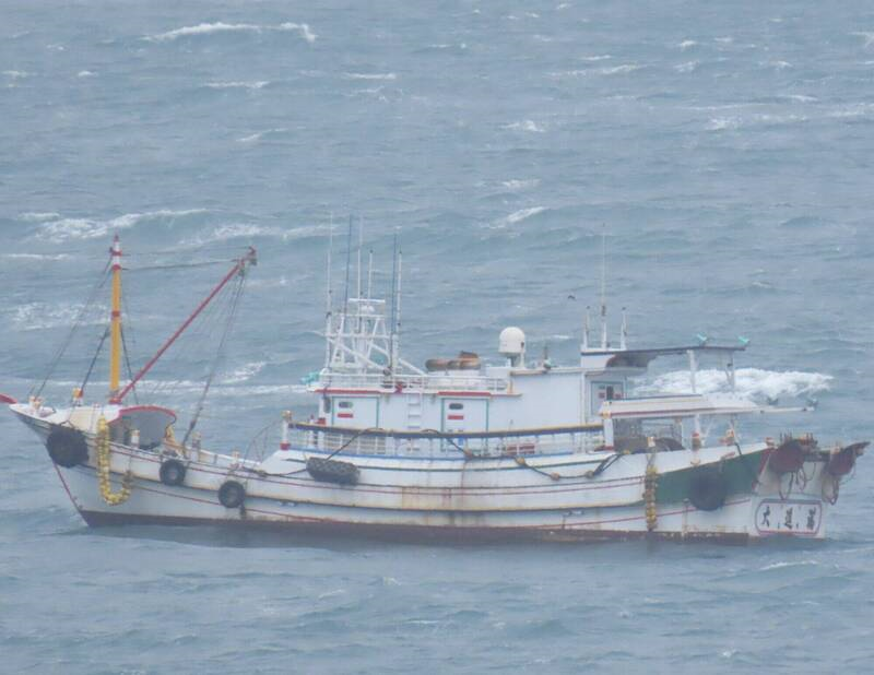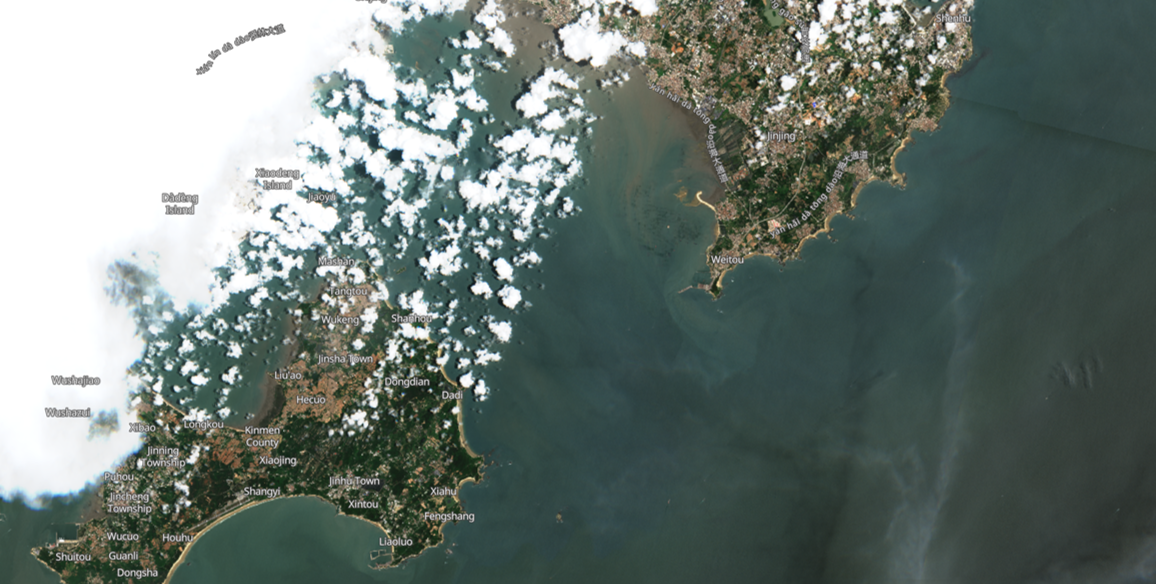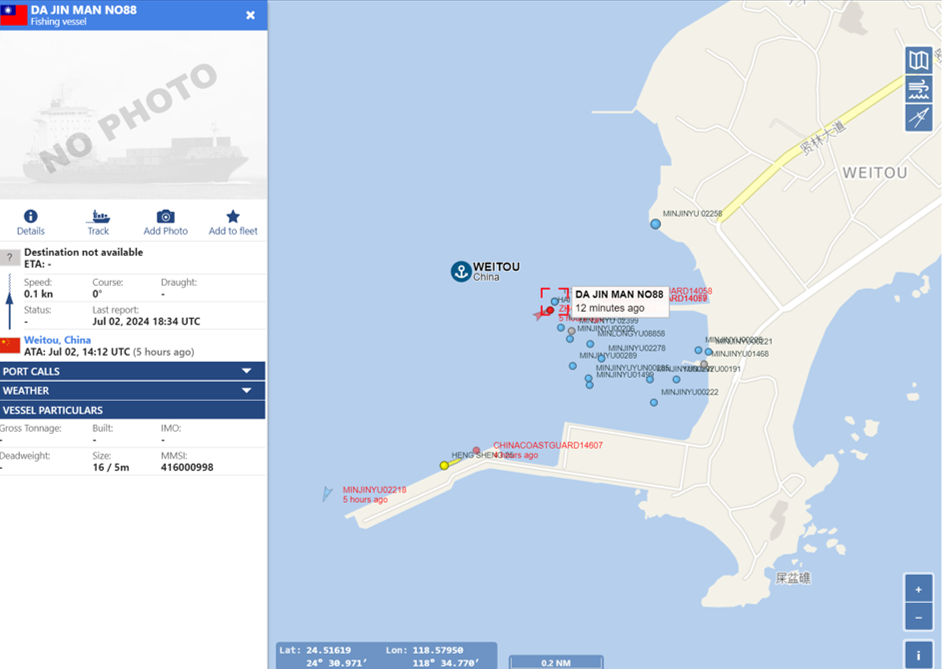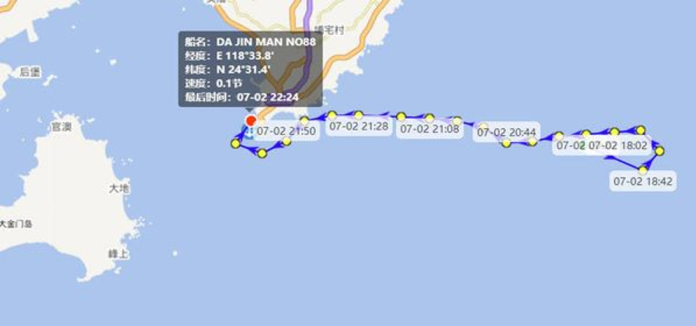On July 2nd, a China Coast Guard (CCG) vessel boarded and detained a Taiwanese fishing vessel operating off the coast of Kinmen Island. The CCG vessel then forcibly towed the fishing boat to the Weitou military port. Taiwan’s Mainland Affairs Council (MAC) and Fisheries Department reached out to their Chinese counterparts to negotiate for the release of the vessel and crew.
Boarding and Detainment of Taiwanese Fishing Vessel
According to a statement released by the Taiwan Coast Guard’s (TCG) Kinmen-Matsu-Penghu (Kinmapeng) Branch, they were notified of the incident by the vessel’s owner at 8:14 p.m. local time. The incident owner said two CCG vessels intercepted the ship, the Da Jin Man No. 88, when it was operating approximately 24 nautical miles (44 kilometers) northeast of Chiao-Luo port, located on Kinmen Island. The vessel’s location placed it at least 17 nautical miles (31 kilometers) outside of the island’s restricted area and 25 nautical miles (46 kilometers) west of the Median Line. The owner told the Kinmapeng Branch that personnel from one of the CCG vessels boarded to conduct an inspection of the fishing boat.

The TCG Director and Executive Director of the Ocean Affairs Council, Zhang Zhonglong, set up an Incident Command Center and deployed three TCG vessels operating approximately 31 nautical miles (58 kilometers) to intercept the vessels and prevent other CCG vessels from boarding Taiwanese ships in the area. At 9:14 p.m. local time, three other CCG vessels intercepted one of the TCG vessels when it was 2.9 nautical miles (5.4 kilometers) within China’s territorial sea baseline. The two Taiwanese vessels then issued broadcasts to their Chinese counterparts, requesting they immediately release the fishing vessel. However, the CCG vessels issued requests through radio, loudspeakers, and verbal communication that the TCG ship not interfere with their operation. The Kinmapeng Branch then informed the TCG vessel that four other CCG ships were sailing to their vicinity to reinforce the Chinese vessels.
At 10:00 p.m. local time, the TCG vessels continued to issue requests to release the detained vessel, but the CCG boats ignored them as they continued to tow the vessel. The Taiwanese vessels stopped the pursuit to “avoid escalating the situation” because they were deep inside China’s territorial baseline. The CCG ships escorted the Da Jin Man to Weitou Military Port, where CCG personnel began to conduct “further investigation” involving the six detained crew members and vessel. Maritime traffic tracking software showed the Da Jin Man anchored near one of the port’s piers. The tracking software showed four CCG and China Maritime Militia vessels located near the Da Jin Man, likely guarding the fishing vessel.

Zhang then arranged a meeting with the CCG to discuss the situation and request the release of the Da Jin Man and its crew. The TCG also began to coordinate with the MAC and the Ministry of Agriculture’s Fisheries Department regarding their response to the incident. The TCG also urged China not to politicize the incident because it would “jeopardize cross-strait relations” and to release the vessel. The CCG, China’s Ministry of Foreign Affairs, or the Taiwan Affairs Office (TAO) did not issue statements about the incident.

Seizure is China’s Escalation of Challenge to Taiwan’s Boundaries
The seizure of the Da Jin Man and its crew represents a significant increase in tensions between China and Taiwan in the area surrounding Kinmen Island. Furthermore, the incident also represents an escalation in China’s continued challenging of the prohibited and restricted boundaries around Kinmen and other Taiwanese islands off the Chinese coast. The incident occurred approximately two months after the CCG announced they would conduct routine maritime law enforcement patrols around Kinmen. Taiwan chose to challenge the patrols by intercepting the CCG vessels and blocking them from nearing Kinmen. China probably decided to seize the Da jin Man to punish Taiwan for enforcing the prohibited and restricted boundaries around Kinmen by intercepting the CCG vessels.
The vessel’s seizure allows China to enhance its challenge of the status quo around Kinmen and demonstrate its belief that the boundaries around the islands have no meaning because they are a part of China. Previously, China and Taiwan had a gentleman’s agreement that allowed fishing vessels from both sides to have full access to the waters around Kinmen. However, China’s view on the agreement changed because of the February 14th incident. China began to challenge the status quo because the country viewed the incident as crossing an unstated red line regarding Kinmen and the integration process. Furthermore, China views Kinmen as a location most receptive to or vulnerable to integration with the mainland. The integration process would include a tacit agreement that allowed boats from both sides to operate in the waters surrounding Kinmen and other Taiwanese islands along the coast. The incident changed this calculus because China viewed Taiwan’s actions as increasingly moving against the integration process, especially after the inauguration of William Lai as President of Taiwan.
The CCG’s seizure of the vessel stands out because the incident occurred after the organization released new administrative regulations that allowed CCG personnel to detain people or vessels that illegally trespass into the country’s territorial waters. However, China did not need the laws to justify the detention of the Taiwanese vessel because the country would view both the vessel and the waters as inherently part of “One China.” Furthermore, the regulations were aimed at foreign vessels operating in disputed waters that China views as being their territory, such as the South China Sea and the waters surrounding the Senkakus. However, China could possibly use the regulations to justify the detention as part of a disinformation campaign to show Taiwan that the boundaries no longer have any meaning and that the island is not internationally recognized by China as a separate entity.

